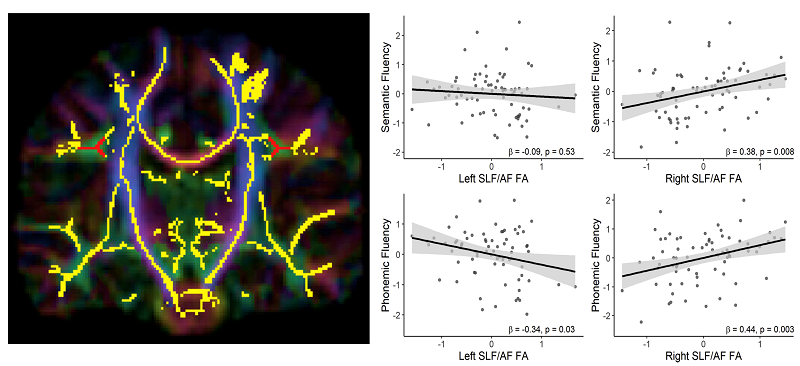New paper out in Developmental Cognitive Neuroscience. We examined associations of verbal fluency performance with frontal and temporal language-related brain regions and their connections in typically-developing children aged 7-13 years.

Better semantic and phonemic fluency performance was associated with higher right superior longitudinal fasciculus/arcuate fasciculus (SLF/AF) fractional anisotropy (FA), and phonemic fluency was also modestly associated with lower left SLF/AF FA.
Explorative voxelwise analyses for semantic fluency suggested associations with FA in other white matter fiber tracts, including corpus callosum and right inferior fronto-occipital fasciculus.
Verbal fluency performance in children may rely on right hemisphere structures, possibly involving both language and executive function networks, and less on solely left hemisphere structures as often observed in adults.
Abstract
"Verbal fluency is the ability to retrieve lexical knowledge quickly and efficiently and develops during childhood and adolescence. Few studies have investigated associations between verbal fluency performance and brain structural variation in children. Here we examined associations of verbal fluency performance with structural measures of frontal and temporal language-related brain regions and their connections in 73 typically-developing children aged 7–13 years. Tract-based spatial statistics was used to extract fractional anisotropy (FA) from the superior longitudinal fasciculus/arcuate fasciculus (SLF/AF), and the white matter underlying frontal and temporal language-related regions. FreeSurfer was used to extract cortical thickness and surface area. Better semantic and phonemic fluency performance was associated with higher right SLF/AF FA, and phonemic fluency was also modestly associated with lower left SLF/AF FA. Explorative voxelwise analyses for semantic fluency suggested associations with FA in other fiber tracts, including corpus callosum and right inferior fronto-occipital fasciculus. Overall, our results suggest that verbal fluency performance in children may rely on right hemisphere structures, possibly involving both language and executive function networks, and less on solely left hemisphere structures as often is observed in adults. Longitudinal studies are needed to clarify whether these associations are mediated by maturational processes, stable characteristics and/or experience."
You can read the whole article online by clicking HERE, or you can read it as a pdf by clicking HERE.
The project was funded by Lundbeck Foundation and Danmarks Frie Forskningsfond.


